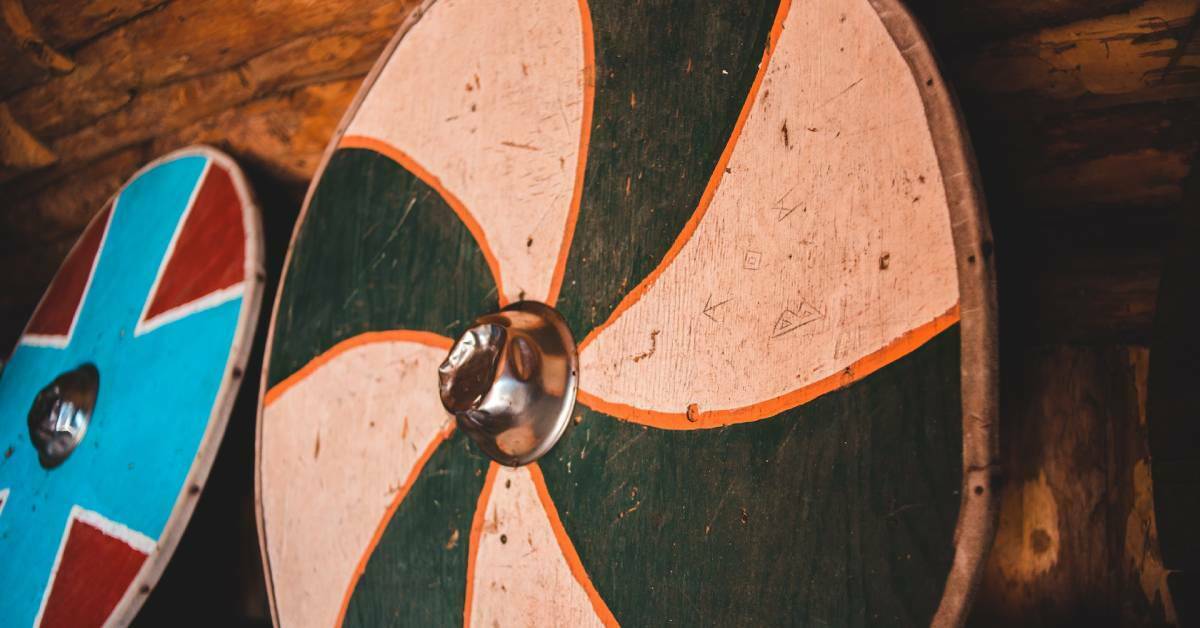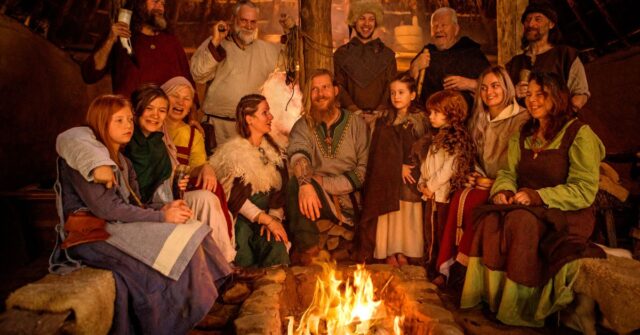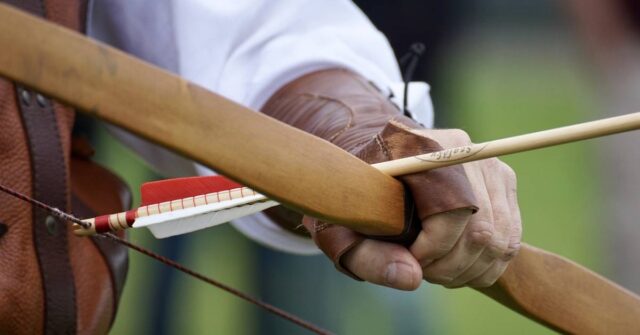Choosing the right Viking shield for reenactments is not just about finding a shield that looks visually appealing.
It also involves considering historical authenticity, quality of materials and craftsmanship, and how the shield complements your role in the reenactment. This comprehensive guide aims to assist you in selecting the ultimate Viking shield for reenactments.
The History of Viking Shields
Viking shields are more than just protective tools. They bear a deep significance in the Viking culture and have undergone various design transformations throughout history.
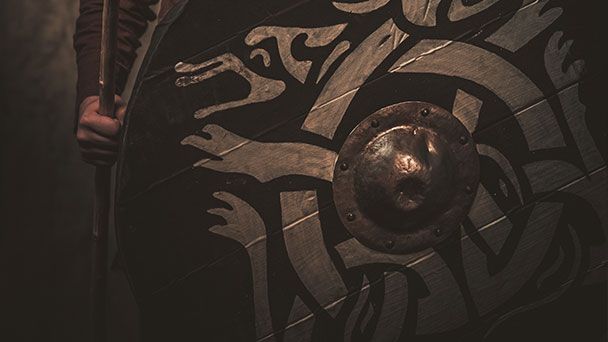
The Role of the Shield in Viking Culture
The shield played an integral role in Viking society. Besides its primary function as a defense mechanism in battles, it also served as a symbol of honor and status.
Each shield was often crafted with meticulous care, displaying the warrior’s personal emblem or colours.
Evolution of Viking Shield Designs
Over time, Viking shield designs evolved to meet the changing demands of warfare. From simple, functional designs to more complex and ornate versions, each shield reflected the Viking era’s state-of-the-art craftsmanship and practicality.
Understanding Viking Shield Anatomy
To choose the right Viking shield, it’s crucial to comprehend its structure and the materials used in its construction. Each part of the shield serves a unique purpose and contributes to its overall functionality.
Parts of a Viking Shield
Typically, a Viking shield consists of four main components: the shield board, boss, rim, and handle with a strap.
The Shield Board
The shield board is the primary body of the shield, usually round and made from planks of wood like oak or pine. The thickness of the board varies, but it is typically designed to be light yet sturdy enough for combat.
The Boss
The boss is the metal dome located at the center of the shield. It serves as a protective cover for the hand and provides additional strength to the shield.
The Rim
The rim of the shield, usually bound with leather or rawhide, provides additional reinforcement and prevents the shield’s wood from splitting during battles.

The Handle and Strap
The handle and strap, located at the back of the shield, allow the warrior to grip and maneuver the shield effectively during combat. The design varies, with some having a single handle and others having a combination of a handle and a strap.
Materials Used in Shield Construction
Viking shields were built using materials readily available during the Viking Age, each contributing to the shield’s functionality and durability.
Wood Types
The choice of wood was crucial in crafting a Viking shield. The most commonly used woods were linden, pine, and oak, valued for their balance between weight and durability.
Metal Elements
Iron was primarily used for the shield boss and sometimes for added reinforcement. Its strength and availability made it an ideal choice during the Viking Age.
Shield Coverings
Shields were often covered with a layer of leather or linen, glued to the wood. This covering not only offered an extra layer of protection but also provided a canvas for painting.
Types of Viking Shields
While most people imagine a round wooden shield when thinking about Viking shields, there was some variation in design, particularly towards the end of the Viking age.
Round Shields
Round shields were the most common type of Viking shields. They ranged from small bucklers to larger war shields, providing ample protection while still allowing for an effective offense.
Kite Shields
Kite shields, which are more elongated and pointed at the bottom, emerged towards the end of the Viking age. These shields offered better leg protection and were often used by cavalry.
Considerations When Choosing a Viking Shield
When selecting a Viking shield for reenactments, there are a few key factors to take into account to ensure it suits your needs.
The Authenticity of the Shield
Historical accuracy is crucial in reenactments. Ensure the shield you select accurately reflects the design, materials, and craftsmanship of the Viking age.
Size and Weight
The shield’s size and weight should match your physique and strength. A too-heavy or oversized shield can hinder your movements and tire you out quickly.
Quality of Materials and Craftsmanship
The materials and the craftsmanship of the shield directly impact its durability and overall performance. Ensure the shield is well-constructed and made of high-quality materials.
Your Role in the Reenactment
Your role in the reenactment also plays a crucial part in choosing a shield. Different characters might have used different types of shields, so consider this when making your selection.
Where To Buy a Viking Shield
There are numerous places where you can purchase a Viking shield, depending on your preferences and budget.
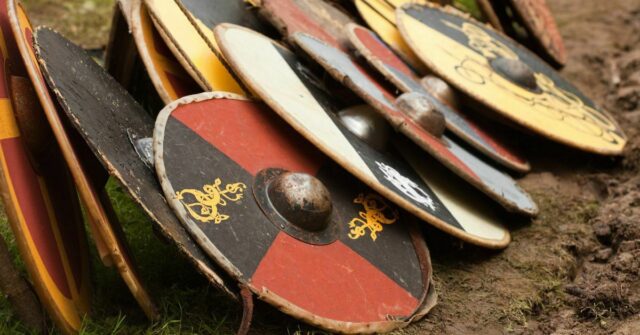
Online Stores
Online stores offer a wide variety of Viking shields from different periods and price ranges. Ensure to purchase from a reputable retailer to guarantee the quality and authenticity of the shield.
Historical Reenactment Events
Historical reenactment events often have vendors selling high-quality, authentic Viking shields. You also get the advantage of seeing and feeling the shield before purchasing.
Local Artisans
Local artisans can craft a customized Viking shield according to your specific requirements. This option might be more expensive but allows you to get a shield that’s tailor-made for you.
Maintaining Your Viking Shield
Once you’ve selected your Viking shield, it’s crucial to properly maintain it to ensure its longevity and performance.
Shield Storage
Always store your shield in a dry, cool place away from direct sunlight. Prolonged exposure to heat and humidity can cause the wood to warp or the metal parts to corrode.
Cleaning and Repairs
Regularly clean your shield to prevent the build-up of dirt and grime. Minor damages and scratches should be repaired promptly to prevent further deterioration.
Periodic Maintenance
Periodically inspect your shield for any signs of wear and tear and take necessary action. This might involve re-gluing the covering or replacing the boss or handle.
Training With Your Viking Shield
Understanding how to effectively use your Viking shield in a reenactment context is just as important as selecting the right shield.

Shield Handling Techniques
Learning how to properly grip, maneuver, and use the shield to defend and attack is crucial. Consider joining a historical combat group or seek out instructional materials to improve your skills.
Safety Precautions
Always follow safety guidelines when training with your shield. Even in reenactments, improper usage can lead to injuries.
Concluding Thoughts
Choosing the ultimate Viking shield for reenactments involves a thorough understanding of Viking shield history, anatomy, and proper handling techniques.
It also requires careful consideration of authenticity, quality of materials, and craftsmanship. By following this guide, you can make an informed choice that enhances your reenactment experience while honoring the rich history of the Viking age.

